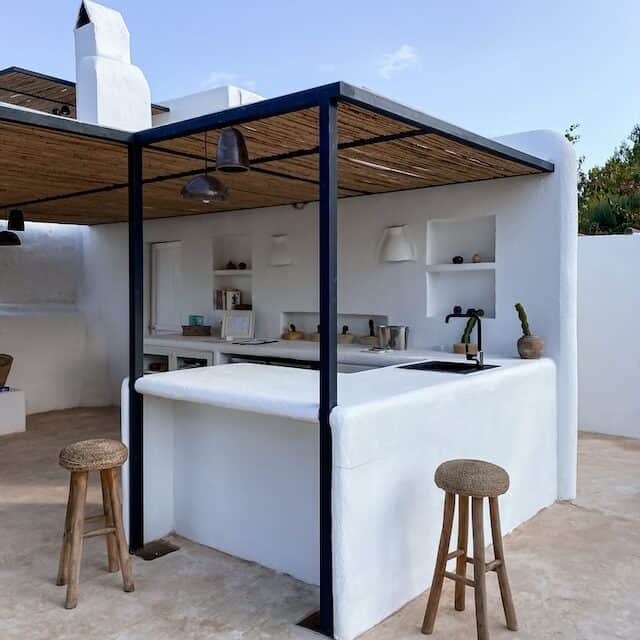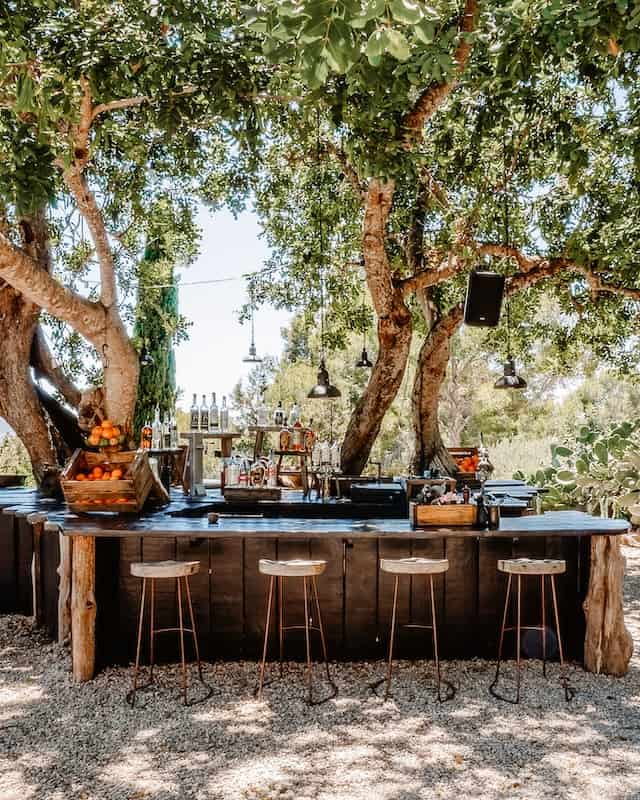Tips for an Easy Outdoor Kitchen Installation
An outdoor kitchen can transform your backyard into a functional and inviting space for cooking, entertaining, and enjoying the outdoors. Whether you’re planning a full-scale outdoor kitchen with all the bells and whistles or a more modest setup, a successful installation requires careful planning and execution.

Choose the right location
Finding the right location for your outdoor kitchen is crucial. There are a few factors to consider.
- Traffic flow – position the outdoor kitchen close to your home to facilitate easy access to utilities like water, electricity, and gas. Ensure the layout of your outdoor kitchen doesn’t obstruct the natural flow of foot traffic in your backyard.
- Exposure – think about the amount of shade and sun the area receives throughout the day. Aim for a balance that allows you to cook comfortably as well as providing shade for guests.
Define your vision
It’s essential to define your vision for the outdoor kitchen. Do you like a classic style or would you rather get a modern outdoor kitchen island? Consider your cooking preferences, entertainment style, and how you plan to use the space. Will you install a simple grill station, a fully equipped kitchen with a sink and refrigerator, or a combination of features? Having a clear vision will guide your decisions throughout the installation.
Plan for utilities
An outdoor kitchen typically requires utilities such as water, gas, and electricity. If your vision includes a sink, gas grill, or refrigerator, plan for the necessary hookups. It’s essential to consult with professionals for utility installation to ensure safety and compliance with local building codes.
Select quality appliances and durable materials
Outdoor kitchens are exposed to the elements, so it’s vital to choose materials that can withstand all weather conditions. Select durable materials like stainless steel, granite, concrete, and natural stone for countertops, cabinets, and flooring. These materials are not only durable but also easy to clean and maintain.
The quality of outdoor kitchen appliances can also significantly impact your cooking experience. Therefore, it is a good idea to invest in high-quality appliances that are designed for outdoor use. This includes a sturdy grill, a weatherproof refrigerator, and a sink with a durable faucet.
In addition to the proper appliances and outside furniture, you’ll want to use the right tools and utensils. Knives will be very important. To find out which ones you need, understanding knives’ uses and functions will help!
Just remember, that it will be much safer to keep your knives in the house so they don’t rust and so that others can’t take them.
Create functional zones and storage
When planning the layout of your outdoor kitchen, don’t forget to create functional zones that mimic the workflow of an indoor kitchen. Designate areas for preparation, cooking, serving, and cleanup to make cooking and entertaining more efficient and enjoyable. Storage is essential for keeping your outdoor kitchen organised and clutter-free. Include cabinets, drawers, and shelves for storing cooking utensils, dishes, and grill accessories. Opt for weather-resistant storage solutions to protect your belongings from the elements.
Plan for lighting
Outdoor kitchen lighting is not only practical but also adds to the ambiance of your al fresco space. Install a combination of task lighting for food preparation areas and ambient lighting for dining and entertaining. Energy-efficient LED lights can withstand outdoor conditions, and if desired, look into smart lighting. You’ll be able to change the lights around the garden with your smartphone, adjusting the mood or the amount available when cooking or dim as everyone is hanging out after the meal.
Think about seating
An outdoor kitchen doesn’t necessarily need seating if you have a patio but it is a good idea to have adequate seating for guests to enjoy meals and conversations. Options include barstools at a countertop, a dining table and chairs, or built-in bench seating. Ensure that the seating arrangement is comfortable and accommodates your expected number of guests. Have extra seating available in case you have more guests than expected. Cushions or folding chairs can be tucked out of the way when not in use.

Add personal touches
The outdoor kitchen should feel like an extension of your home and this can be done by adding personal touches. Decorate with outdoor-friendly textiles like cushions and rugs and incorporate plants, flowers, tableware, and landscaping to enhance the overall aesthetics of the space. Personal touches make your outdoor kitchen a welcoming and inviting environment.
Hire professionals
It is not always easy to execute the perfect outdoor kitchen. While some outdoor kitchen enthusiasts may have the skills to handle the installation themselves, it’s often advisable to hire professionals, especially for complex projects. Professionals can ensure that utilities are correctly connected, appliances are installed safely, and the outdoor kitchen meets all building codes and regulations.
Obtain necessary permits
All the above will help to build your dream outdoor kitchen, but before starting the installation, check with your local government to determine whether you need any permits or approvals for the project. Compliance with local regulations is essential to avoid potential legal issues down the road.
Test your design
Before finalising the installation, it’s a good idea to test and cook a meal or host a small gathering to ensure that the layout, flow, and functionality meet your expectations. Testing allows you to identify any necessary adjustments before everything is ‘set in stone’.
Maintain regularly
Once your outdoor kitchen is installed and operational, make regular maintenance a priority. Basic maintenance steps include cleaning surfaces, appliances, and equipment regularly to prevent damage and deterioration. Use approved supplies to prevent damage to appliances or counters. Inspect and service gas lines, electrical connections, and plumbing periodically to ensure everything remains in proper working order. This will help catch potential issues faster.
Consider All-Weather Protection
To extend the usability of your outdoor kitchen throughout the year, consider all-weather protection options. This may include retractable awnings, pergolas, or outdoor curtains that provide shade and shelter from rain. All-weather protection ensures that you can enjoy your outdoor kitchen regardless of the weather conditions.
Conclusion
Installing an outdoor kitchen is a rewarding project that can enhance your outdoor living experience and add value to your home. By defining your vision, choosing the right location, planning for utilities, and investing in quality materials and appliances, you can create a functional and enjoyable outdoor kitchen space. Hiring professionals when necessary, obtaining permits, and conducting testing will help ensure a smooth installation process. Regular maintenance and thoughtful touches personalise your outdoor kitchen, making it a true extension of your home. With careful planning and attention to detail, you can enjoy countless meals and gatherings in your outdoor kitchen for years to come.
Round-up of bbq information
Equipment:
Gas barbecue reviews
Electric indoor grill reviews
BBQ utensils and accessories
Grill pan reviews
Outdoor dinnerware
Barbecuing and grilling information:
How to host a bbq in 6 steps
7 Steps to grilling on a gas barbecue
Setting up your outdoor kitchen area
BBQ vs grilling vs smoking
Recipes:
Grilled watermelon with feta cheese
Asian chicken skewers on the grill
Marinated monkfish kebabs on the grill
Grilled marinated lamb with wine and peppercorns
Grilled pork cheeks with white peaches
Mediterranean lamb chops on the grill
Grilled prawns in green herb marinade
Chinese pork ribs on the barbecue
Potato salad is the perfect barbecue sidedish